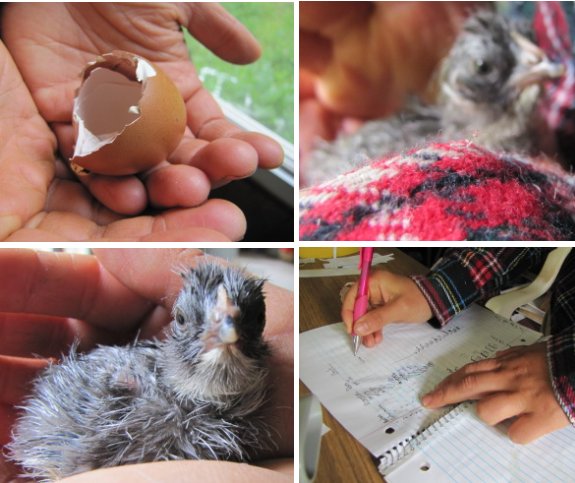
Latest homegrown chick 3.0

Our third homegrown
chick showed up today a bit earlier than predicted.
Not sure when we'll get
accustomed to all this eggcitement during the hatching phase.
In my opinion it's 10 times
more entertaining than any television I can remember.
Want more in-depth information? Browse through our books.
Or explore more posts by date or by subject.
About us: Anna Hess and Mark Hamilton spent over a decade living self-sufficiently in the mountains of Virginia before moving north to start over from scratch in the foothills of Ohio. They've experimented with permaculture, no-till gardening, trailersteading, home-based microbusinesses and much more, writing about their adventures in both blogs and books.
Want to be notified when new comments are posted on this page? Click on the RSS button after you add a comment to subscribe to the comment feed, or simply check the box beside "email replies to me" while writing your comment.

Hmm... It shouldn't have surprised me that any discussion about bats would have lead to fertilizer.
Guano can be a first step to making gunpowder too, so I should also remember the virtues of guano. :P
Dung heaps were indeed a common source of potassium nitrate. Especially when the ashes from wood fires were added. There were specially built nitre-heaps made for creating potassium nitrate.
Another method is to let urine decompose in straw for some months, wash out the calcium nitrate with water and filter it through wood ash to convert it to potassium nitrate, followed by drying.
The big disadvantage of black powder is the high amount of solid combustion products, causing fouling of guns. Apart from reproductions of older guns, I don't think many modern firearms would be suited for using gunpowder. Smokeless powder (based on nitrocellulose a.k.a gun-cotton) has been around for around 150 years now, and is much more powerful.
Search for "exploding apron" for an interesting story about the discovery of nitrocellulose. BTW, don't try that at home, unless you want to blow yourself up and your house. Guncotton by itself is not very stable.
If you want to make your own ammunition completely yourself, you'd basically have to go back to a flintlock smoothbore musket or rifle muzzle-loaders. For those you only need;
The first three are needed for the propellant (black powder). Lead is used to cast bullets (no metal jackets in those days) and flint is needed to ignite the gunpowder.
Roland --- And, presumably, the further back you get in gun technology, the less safe it becomes. I think that's one of the last DIY projects I'd actually undertake.
Vester --- It seems like most of the things I love most come from the tail end of an animal. Eggs, compost...
If you want to make it yourself, black powder is probably the least dangerous.
More advanced propellants like guncotton or its derivative smokeless powder are made by chemical processes that are not very suitable to DIY due to the nature of some of the materials (strong acids) and the required precise control of reaction parameters like temperature and purity of reactants.